Digital Video Portraits Capture Internal and External Spaces
by Russell Boniface
Associate Editor
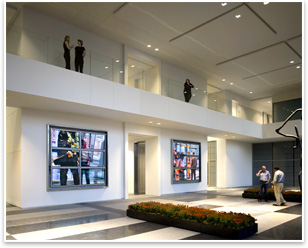 How do you . . . create a new art form using digital technology that architects would find appealing? How do you . . . create a new art form using digital technology that architects would find appealing?
Summary: Chicago-based artist Lincoln Schatz is wowing architects with his generative digital video portraits. His video work, called media art, gathers images of external or internal spaces using digital video cameras to create a changing collage of images, or portraits, shown on plasma screens. His video portraits have has been commissioned by architects in Chicago and include the new 600 North Fairbanks high-rise tower designed by Helmut Jahn, McCormick Place Convention Center, Spertus Museum, and the Blackstone Hotel on Michican Avenue. Schatz’s work called “Cluster” garnered raves at last year’s Sundance Film Festival art program and was seen as a new non-linear means of filmmaking. He recently showcased at the PULSE art show in Miami, will begin work for the Hearst Tower in New York City, and hopes to showcase at the Corcoran Gallery in Washington, D.C. His current CUBE project, a 10-foot x 10-foot translucent architectural structure, uses 24 video cameras that record an individual in a cube for one hour, forming a changing, 24-hour digital rendering.
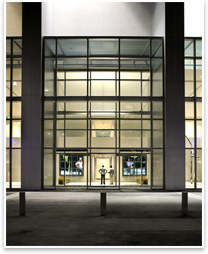 Lincoln Schatz, a former sculptor and avid architecture buff, uses pan, tilt, and zoom robotic cameras to collect digital video images from the environment or an internal space. Using software he developed, the images are assembled to form a portrait that is shown on a plasma screen. His works have been commissioned by architects for commercial buildings, the residential sector, and museums. He calls the process generative digital video portraits, or time-based media. “The portrait is a digital video recording over time of an internal or external space, but when it’s replayed on the plasma screen it’s not played back in a linear fashion,” Schatz explains. Lincoln Schatz, a former sculptor and avid architecture buff, uses pan, tilt, and zoom robotic cameras to collect digital video images from the environment or an internal space. Using software he developed, the images are assembled to form a portrait that is shown on a plasma screen. His works have been commissioned by architects for commercial buildings, the residential sector, and museums. He calls the process generative digital video portraits, or time-based media. “The portrait is a digital video recording over time of an internal or external space, but when it’s replayed on the plasma screen it’s not played back in a linear fashion,” Schatz explains.
Changing portraits
An example, he notes, is his recent public commission for the 600 North Fairbanks project, a Chicago high-rise designed by Helmut Jahn. Schatz captured the 18 months of construction with digital cameras to create a digital video portrait, now displayed on a plasma wall screen in the lobby. “If you look at the digital video of the high-rise construction of the new Helmut Jahn building, you’re not watching something from A to Z., with a beginning or end. Rather, it’s generative—the images are reassembled in different ways by the software to form a composite on a plasma screen, and each moment of assembly is unique. Like a dream.”
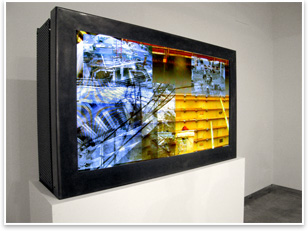 About seven years ago, Schatz recalls, he started working with computers for a commission with structural engineers and architects that warranted a way for all to communicate. He taught himself CAD modeling and worked within animation software and digital models. “I could take a sculptural shape, replicate it 10 times, and give each iteration of the shape a different set of physical qualities, whether it was weight, gravity, or wind sheer. I would gather these unique objects to a height in virtual space, and they would knock and bump into each other. What would come out of that is a video of these things colliding. What I realized after doing this for a while was that my real interest wasn’t controlling what would take place, but rather the idea that something was taking place outside my control. That is the basis of this generative video work.” About seven years ago, Schatz recalls, he started working with computers for a commission with structural engineers and architects that warranted a way for all to communicate. He taught himself CAD modeling and worked within animation software and digital models. “I could take a sculptural shape, replicate it 10 times, and give each iteration of the shape a different set of physical qualities, whether it was weight, gravity, or wind sheer. I would gather these unique objects to a height in virtual space, and they would knock and bump into each other. What would come out of that is a video of these things colliding. What I realized after doing this for a while was that my real interest wasn’t controlling what would take place, but rather the idea that something was taking place outside my control. That is the basis of this generative video work.”
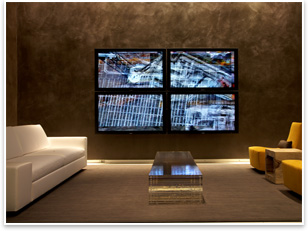 A memory over time A memory over time
Generative digital video, Schatz says, is a composite of digital video bits from digital cameras looking at a subject—whether an environment or person. The cameras are attached to a computer, and his software forms an ongoing collage of imagery. “It’s creating a memory over time,” he explains. “On the plasma screen you would see an iteration of yourself or the environment within the past minute of real time being juxtaposed with images going back in time. It expands the definition of portrait beyond an individual portrait or portrait of place.”
The 600 North Fairbanks video portrait was collected from cameras mounted at various points on a tower crane, an adjacent building, and from a handheld video camera operated by Schatz. “The Helmut Jahn high-rise portrait was a constant process,” he says. “All those feeds were sucked through my software, which parsed the images and discarded some images through its own internal logic. What came out of it is a non-linear look at the construction of a high-rise tower, which is now installed in the lobby.”
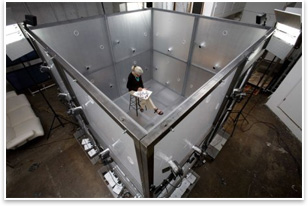 Enter the CUBE Enter the CUBE
The project Schatz is currently working on is called CUBE, a 10-foot x 10-foot translucent cube structure. The cube is made of welded steel and milled acrylic and features 24 digital videos cameras mounted into it, each connected to its own computer. “It’s a straight portrait project,” describes Schatz. “You go into the space for one hour, and that one hour would generate up to 24 hours of digital video images that are continuously recombined by my software. The end product on the plasma screen is constantly churning and recompositing your portrait.”
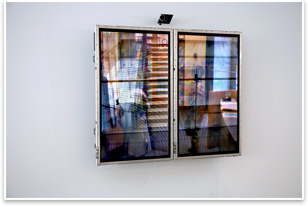 Looking out at the city; looking out at the country Looking out at the city; looking out at the country
A commission for the Blackstone Hotel in Chicago features Schatz’ work on two large plasma screens in the lobby. His pan, tilt, and zoom digital video cameras on the hotel roof continuously scan the horizon and reassemble images on the plasma screens. He is also working on a commission for New York City-based Gluck and Partners on a Lake George, N.Y., retreat project. “The screen will be inside the building, with a camera above it that captures footage from inside, while externally there will be a pan, tilt, and zoom camera that has wide range of movements that collects information from the idyllic setting. The internal and external images composite together on screen.”
Schatz, who professes to believe he is the first generative video artist, currently is involved in discussions on exhibiting his generative digital video at the Corcoran Gallery in Washington, D.C. “The most exciting part of the process is I don’t have control of what’s being recorded,” Schatz concludes. “The images are a series of chance operations that yield results that I can’t forecast. It’s a lot of fun to do.”
|


 How do you . . .
How do you . . .



